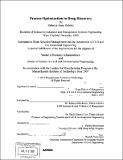| dc.contributor.advisor | Rebecca Henderson and David Simchi-Levi. | en_US |
| dc.contributor.author | Roberts, Rebecca Anne, M.B.A. Massachusetts Institute of Technology | en_US |
| dc.contributor.other | Leaders for Manufacturing Program. | en_US |
| dc.date.accessioned | 2007-12-07T16:08:03Z | |
| dc.date.available | 2007-12-07T16:08:03Z | |
| dc.date.copyright | 2007 | en_US |
| dc.date.issued | 2007 | en_US |
| dc.identifier.uri | http://hdl.handle.net/1721.1/39693 | |
| dc.description | Thesis (M.B.A.)--Massachusetts Institute of Technology, Sloan School of Management; and, (S.M.)--Massachusetts Institute of Technology, Dept. of Civil and Environmental Engineering; in conjunction with the Leaders for Manufacturing Program at MIT, 2007. | en_US |
| dc.description | Includes bibliographical references (p. 69-70). | en_US |
| dc.description.abstract | Novartis is one of the largest pharmaceutical companies in the world, with their research headquarters (Novartis Institutes for BioMedical Research) located in Cambridge MA. In this thesis, I explore Novartis's process for developing drugs, specifically the earlier stages of research leading to high throughput screening. During the course of a 6.5 month, on-site project, Novartis's processes were identified, data were collected and relevant literature in product development and organizational structure were surveyed. Based on the accumulation of this information, several opportunities for improvement were identified and from these, recommendations were developed and implemented. This thesis considers the improvements Novartis could see in their drug discovery process by improving communication between organizations. In particular, I suggest that the company could benefit in cycle time and quality by designing and following more robust lateral processes and by moving their communication mode closer to integrative problem solving. | en_US |
| dc.description.abstract | (cont.) Following these recommendations, I investigated why Novartis did not already have these processes in place. I hypothesize that the main reason for this is because the research organization at Novartis is focused primarily on exploration, therefore their ability and need to coordinate has not been an area of focus. Novartis has made a very deliberate effort to design an organization that promotes novel drug discovery; perhaps sacrificing cycle time and process efficiency. Because of this strong focus on drug discovery, Novartis has not had opportunity to design and implement efficient processes. By bring in interns from MIT's Leaders for Manufacturing Program, the company is beginning to explore ways to improve their processes without sacrificing their ability to develop novel drugs. | en_US |
| dc.description.statementofresponsibility | by Rebecca Anne Roberts. | en_US |
| dc.format.extent | 81 p. | en_US |
| dc.language.iso | eng | en_US |
| dc.publisher | Massachusetts Institute of Technology | en_US |
| dc.rights | M.I.T. theses are protected by copyright. They may be viewed from this source for any purpose, but reproduction or distribution in any format is prohibited without written permission. See provided URL for inquiries about permission. | en_US |
| dc.rights.uri | http://dspace.mit.edu/handle/1721.1/7582 | |
| dc.subject | Sloan School of Management. | en_US |
| dc.subject | Civil and Environmental Engineering. | en_US |
| dc.subject | Leaders for Manufacturing Program. | en_US |
| dc.title | Process optimization in drug discovery | en_US |
| dc.type | Thesis | en_US |
| dc.description.degree | S.M. | en_US |
| dc.description.degree | M.B.A. | en_US |
| dc.contributor.department | Leaders for Manufacturing Program at MIT | en_US |
| dc.contributor.department | Massachusetts Institute of Technology. Department of Civil and Environmental Engineering | |
| dc.contributor.department | Sloan School of Management | |
| dc.identifier.oclc | 176027331 | en_US |
